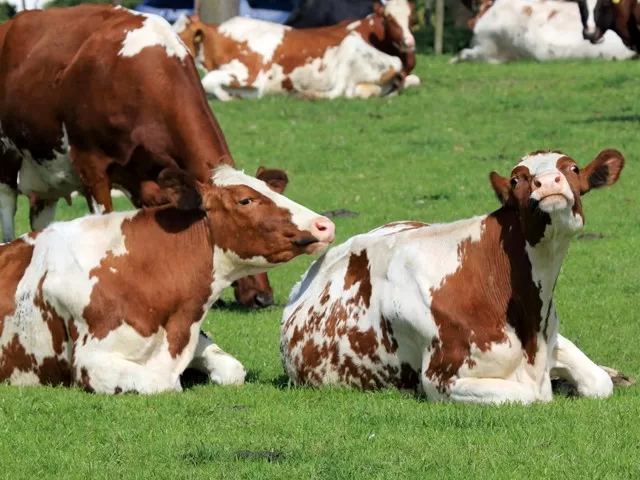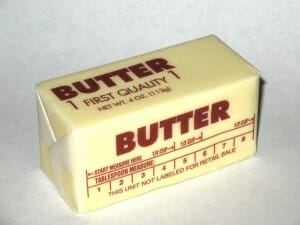Recently, I have received several reports of low butterfat tests showing up in dairy herds in Minnesota. This is usually a cause for concern because it generally indicates that something is wrong. What is a low butterfat test? It depends on the breed, production level, past history, the producer’s comfort level and how much it dropped. There are reports in the low 3’s. That is too low by most standards.
Before looking for reasons, let’s first review how low butterfat tests come about. Approximately half of the fatty acids in butterfat in milk are synthesized in the mammary gland. The other half is fatty acids that are absorbed from the bloodstream. Fatty acids are attached to glycerol to make triglycerides, which make up butterfat. There can be hundreds of different combinations of fatty acids in the triglycerides; about a third of these are even unsaturated. Many are familiar with acetate to propionate ratio. If the ratio gets too low, we tend to see lower butterfat in the milk. This is because acetate and butyrate are used to make the fatty acids in butterfat while propionate is used to form glucose, which is used to make lactose in the mammary gland. The amount of lactose produced is directly proportional to the volume of milk produced.
So how does this result in lower butterfat test? One scenario is that higher milk volume may lower test by virtue of dilution. Calculating fat-corrected milk might show that to be the case. The formula for fat-corrected milk is: 3.5% FCM = (0.4324 x lb of milk) + (16.216 x lb of milk fat). A good thumb rule to use is: add or subtract one pound of milk for every one-tenth percentage point change above or below 3.5 percent fat test. For example, if a herd averages 70 pounds of milk with a 3.9 percent milk fat, the estimated pounds of 3.5% FCM would be 74 pounds. However, a more likely scenario may be in feeding too much grain or too little fiber, resulting in a condition known as sub-acute rumen acidosis. These conditions tend to increase the amount of propionate and also lactic acid produced. When a rumen is in balance, it maintains a pH of about 6.0 to 6.2 by having enough buffer from saliva to counter acid production. There are also some rumen bacteria, which will consume lactic acid. By this time of year, corn silage and high moisture corn are fully fermented and very digestible leading to more rapid starch breakdown. Therefore, make sure effective fiber levels are adequate, include buffer at adequate amounts and monitor free-choice buffer consumption as an indicator of acidosis. In addition, check forage dry matters, accuracy in mixing, changes in feeds and diet formulation.
Other factors that can affect butterfat test:
- The type and amounts of added fat to the diet.
- Feeding monensin may decrease butterfat test by 0.1%.
- The presence of mycotoxins. Certainly, the problem of molds was widespread last fall and may be impacting our feed quality. Mycotoxins have been shown to be lethal to some rumen bacteria and can also inhibit NDF digestion by rumen bacteria, resulting in lower acetate production.
- Too much vegetable fat can also be lethal to rumen bacteria. Rumen bacteria will convert some of the unsaturated fatty acids to saturated fatty acids. If there is too much vegetable fat in the ration, the rumen bacteria will be over-supplied compared to their ability to keep up. When this happens, incomplete conversion occurs and the resulting fatty acids actually inhibit triglyceride production in the mammary gland, resulting in severe butterfat test reduction.
With this background information, what should we consider? First, look at the cows. Are at least half of them chewing their cud? Does the manure look looser than usual? Is it watery or bubbly, indicating some degree of acidosis? Next, look at all the feedstuffs. Is there any mold present? If so, have some tests done to identify them and quantify amounts. Work with your nutritionist to determine if some additive might help. Consider a probiotic or more buffer. Review your ration on paper. Does it match what you are feeding? Check your sources and amounts of fat in the diet. Limit the amount of vegetable fat in the diet. Check forage dry matter. Look at particle size of the ration fed. Is mixing time too long? Have you noticed any increase in lameness or sore and touchy hooves?
There are many possible reasons for a lower butterfat test, especially at this time of year. If you are struggling with a chronic low butterfat test, get your team together to help solve the problem. Low butterfat tests indicate a compromise to the cow’s health and it means lower returns for the farm.


